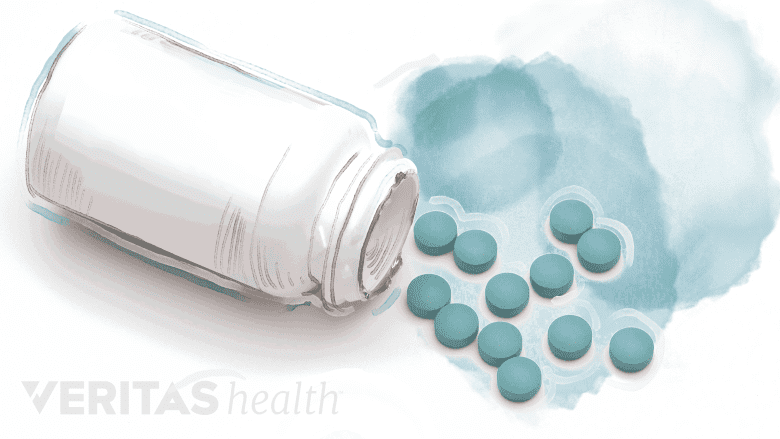The L3-L4 spinal motion segment is typically treated with nonsurgical methods. Tumors, infections, and/or other causes of severe nerve root compression with significant neurological deficits may be treated surgically.
In This Article:
Nonsurgical Treatments for L3-L4

Prescription and over-the-counter (OTC) medication may help reduce lower back and leg pain.
Treatment of the L3-L4 motion segment usually involves one or more of the following methods:
- Medication. Both over-the-counter (OTC) and prescription medications are used to treat pain stemming from L3-L4, including nonsteroidal anti-inflammatory drugs (NSAIDs), opioids, tramadol, and/or corticosteroids. Before using any medication, read warning labels carefully.
- Immobilization. Using a back brace after an acute injury, such as fracture, may help promote healing of tissues and prevent further injury.
- Physical therapy. Exercise and physical therapy can help strengthen neck muscles, improve posture, and increase the range of motion after an L3-L4 injury. Physical therapy is usually performed under the guidance of a physical therapist and may include exercises, stretches, manual therapy, massage, and/or other treatments.
- Chiropractic manipulation. Chiropractic adjustment of the lumbar spine may help relieve pain stemming from the L3-L4 motion segment.
- Injection. Spinal nerve pain from L3 may be treated with steroid injections in the epidural space or into the L3-L4 facet joint. Risks of these injection procedures include hematoma, bleeding, and/or nerve damage. Fluoroscopic (x-ray) guidance with radiopaque contrast dye is used for correct needle placement and helps to improve diagnostic accuracy and decrease procedural risks.
Self-care measures, such as using correct posture while standing, sitting, walking, lying down, and lifting items off the floor is important to maintain a normal spinal curvature, minimize stresses, and facilitate healing.
Surgical Treatments for L3-L4

Surgical fusion of the L3-L4 spinal segment may be recommended for added stability.
The goal of lumbar spine surgery is typically aimed at relieving compression of a nerve root and/or the cauda equina.
Surgical options may include:
- Laminectomy. The lamina (area of bone at the back of the vertebra) is removed in order to provide more room for the cauda equina.
- Foraminotomy. The opening for the spinal nerve root (intervertebral foramen) is enlarged by trimming bony overgrowth, relieving nerve compression.
- Microdiscectomy. A small part of the disc material near the nerve root is taken out. A portion of the bone adjacent to the nerve root may also be trimmed to relieve compression.
- Facetectomy. Trimming and/or removing a part of the facet joints and/or bony overgrowths to relieve nerve root compression.
- Fusion of L3-L4. Depending on the extensiveness of the surgery and the amount of bone removed, the surgical segment may be fused with the adjacent motion segment to provide stability.
- Lumbar artificial disc replacement. This surgery is not very common and includes a complete replacement of the lumbar intervertebral disc to relieve nerve root compression and replace it with an artificial implant.
As with any surgery, there is always a small risk of serious complications, such as infection, nerve injury, excessive bleeding, or severe allergic reaction. Before deciding to have surgery, it is important to discuss the risks and alternatives to surgery with the surgeon. It is also important to understand the possible complications if surgery is not performed.

